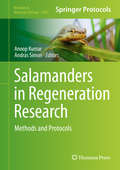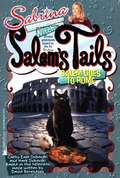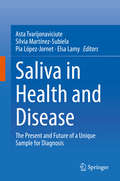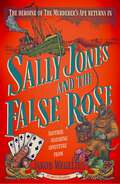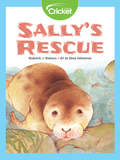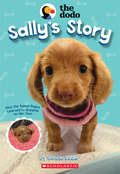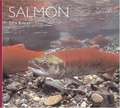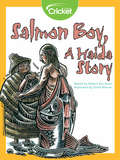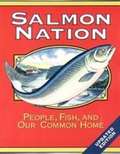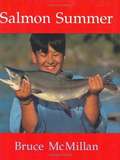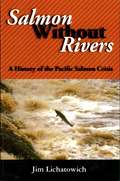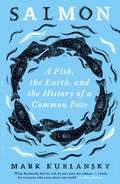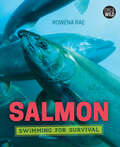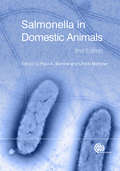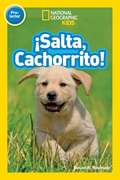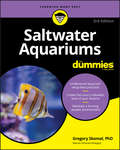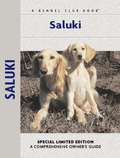- Table View
- List View
Salamanders in Regeneration Research
by Anoop Kumar András SimonThis detailed volume focuses on best practices and conditions for maintaining the most commonly used salamander species in the laboratory. Salamanders in Regeneration Research: Methods and Protocols guides readers through experimental manipulations in vivo and in vitro, respectively. With methods on targeting a wide variety of structures, ranging from the limb to the heart and to the brain, and methods for studying genetically modified organisms and tools for mining in the genomic databases. Written in the highly successful Methods in Molecular Biology series format, chapters include introduction to their respective topics, lists of the necessary materials and reagents, step-by-step, readily reproducible laboratory protocols, and tips on troubleshooting and avoiding known pitfalls. Authoritative and up-to-date, Salamanders in Regeneration Research: Methods and Protocols provides a comprehensive collection of methods chapters.
Salem Goes to Rome: Salem's Tails
by Cathy East Dubowski Mark DubowskiWhen in Rome...EAT! Salem and his hamster-pal Stonehenge are on their own in the Eternal City, and hungry for pizza! Real pizza, from a restaurant that delivers. But instead of a pizza delivery guy, a burglar sneaks in and steals Sabrina's magical gold locket! Salem and Stoney will be in real trouble if they don't catch the thief. So they hightail it through the famous streets of Rome-onto the turf of Italian cats cruising for hamster antipasto, and around a crazy movie set-as they race to retrieve the locket before Sabrina, the Teenage Witch returns!
Saliva in Health and Disease: The Present and Future of a Unique Sample for Diagnosis
by Asta Tvarijonaviciute Silvia Martínez-Subiela Pia López-Jornet Elsa LamySaliva as a unique sample for health assessment is gaining attention among researchers of different fields in the last 20 years; being reflected in an impressive increase in the number of papers published studying saliva from different biological aspects in human and veterinary species. Once deemed merely a digestive juice is now considered a biological fluid capable of communicating information about physiopathological processes occurring in organisms, since saliva has been shown to contain molecular and bacterial compounds that can change in response to local and systemic pathologies. Furthermore, the interest of saliva as a diagnostic, prognostic and monitoring biofluid is forced by its non-invasive nature being of easy and inexpensive sampling, involving only minimal discomfort and allowing the collection of multiple/repeated specimens at anytime, anywhere and without need for specialized staff. In this contributed volume, the authors bring together, summarize and reflect the generated knowledge about saliva as a source of biomarkers for health and welfare evaluation in humans and animal models. This volume also highlights the importance of confounding factors, such as sampling methods, flow, total protein content, contamination, or storage. This book will serve as a manual for graduates, practitioners and researchers by providing general ideas about the possibilities and utilities of saliva in clinical practice or investigation, and indicating the main cautions each should have in mind before saliva usage.
Sally Becomes A Guide Dog
by Angela Lucas Derek LucasFollow Sally as she is born, raised, and trained to become a guide for someone who is blind.
Sally Jones and the False Rose
by Jakob WegeliusSally Jones returns in the thrilling sequel to The Murderer's Ape! With gorgeously detailed black-and-white illustrations throughoutWhen Sally Jones and The Chief discover a curious rose-shaped necklace hidden onboard their beloved Hudson Queen, it's the start of another perilous adventure for the seafaring gorilla and her faithful friend. Determined to get to the bottom of the mystery, they set sail for Glasgow, but there fall into the clutches of one of the city's most ruthless gangs, commanded by a fearsome smuggler queen who will stop at nothing to snatch the necklace for herself. Held prisoner hundreds of miles from friendship and safety, Sally Jones must use all her strength, determination and compassion to escape and unravel the mysterious story of the False Rose - a twisting tale leading all the way from Lisbon to Shetland and the South Seas.
Sally's Rescue
by Roderick J. RobinsonAnna and Jim find a baby seal trapped in a fishing net on the beach after a storm. With the help of their parents, the two siblings are able to get the seal untangled. But where is her family? See how this family helps Sally the seal, return to her parents!
Sally's Story (The Dodo)
by Bonnie BaderThe true story of how one little puppy learned to breathe on her own -- as seen on The Dodo!When Sally was rescued, this tiny dachshund puppy couldn't eat or breathe without help. Sally had a feeding tube to give her food and medicine. And she had to stay inside a plastic bubble to get the extra oxygen she needed.But Sally was determined to breathe on her own. She practiced spending small amounts of time outside her bubble. Slowly but surely, Sally's lungs grew healthy and strong. With the love and support of those around her, Sally showed the world what it means to never give up!This story is perfect for middle-grade readers and includes eight-pages of full-color photos!
Salmon (Nature's Children)
by Elma SchemenauerSalmon are a amazing fish. Starting out as tiny pink eggs they grow up to be very powerful fish, and swim home to breed again in their home stream. They will try their hardest to get there. Learn more about these fascinating and sometimes enormous fish.
Salmon (WorldLife Library)
by John M. BaxterThe life cycle of the salmon is a remarkable story of survival. Their amazing feat of migration from freshwater streams to saltwater oceans and back again is one of the great wonders and mysteries of the natural world. In this authoritative book, John Baxter uncovers the origins, migratory instincts, and life histories of the seven salmon species found around the world: Atlantic, chinook, coho, sockeye, masu, pink, and chum. He also explores the many conservation issues facing salmon today, which are declining because of pollution, overfishing, and changes to river habitats.
Salmon (Worldlife Library)
by John Baxter Carlton RayProvides information about the main species of salmon, their evolution, life cycles, migration, and threats to their existence, and more.
Salmon Boy, a Haida Story
by Robert San SouciA young Haida boy in the Pacific Northwest learns the importance of honoring the spirits of the salmon caught for food.
Salmon Nation: People, Fish, and Our Common Home
by Elizabeth Woody Edward Wolf Seth ZuckermanSalmon Nation takes general readers behind the headlines int the company of six knowledgeable guides to a deeper understanding of the most celebrated fish of western North America. Thoughtful essays by Native American writer Elizabeth Woody, fisheries biologist Jim Uchatowich, journalist Richard Manning, former commercial fisherman Freeman House, and writer Seth Zuckerman trace the relationship between people and salmon from the days of abundance that sustained Northwest Coast native cultures to the troubled world of salmon today. Geographer Dorie Brownell's full-color maps offer a powerful big picture perspective that lends new urgency to efforts to heal the breach between people and salmon.
Salmon Summer
by Bruce McmillanA photo essay describing a young Native Alaska boy fishing for salmon on Kodiak Island as his ancestors have done for generations.
Salmon Without Rivers: A History Of The Pacific Salmon Crisis
by James A. LichatowichFrom a mountain top where an eagle carries a salmon carcass to feed its young to the oceanic waters of the California current and the Alaskan Gyre, salmon have penetrated the Northwest to an extent unmatched by other animals. Since the turn of the twentieth century, natural productivity of salmon in Oregon, Washington, California, and Idaho has declined 80 percent. The decline of Pacific salmon to the brink of extinction is a sign of serious problems in the region.In Salmon Without Rivers, fisheries biologist Jim Lichatowich offers an eye-opening look at the roots and evolution of the salmon crisis in the Pacific Northwest. He describes the multitude of factors over the past century and a half that have led to the salmon's decline, and examines the failure of restoration efforts that have focused almost exclusively on hatcheries to return salmon stocks to healthy levels without addressing underlying causes of the decline.Lichatowich argues that the dominant worldview of our society -- a worldview that denies connections between humans and the natural world -- has created the conflict that characterizes the recent history of salmon; unless that worldview is challenged, there is little hope for recovery. Salmon Without Rivers exposes the myths that have guided recent human-salmon interactions. It explains the difficult choices facing citizens of the region, and provides unique insight into one of the most tragic chapters in our nation's environmental history.
Salmon and Other Bony Fish (World Book's Animals of the World)
by Meish GoldishPresents information about the physical characteristics, habits, and behavior of salmon and such related fish as eels, flounder, swordfish, and piranhas.
Salmon: A Fish, the Earth, and the History of a Common Fate
by Mark KurlanskyMost of what we do on land ends up impacting the ocean, but never is that clearer than when we look at salmon. Centuries of our greatest assaults on nature, from overfishing to dams, from hatcheries to fish farms, from industrial pollution to the ravages of climate change, can be seen in their harrowing yet awe-inspiring life cycle. From the Pacific to the Atlantic, through Scotland, Ireland, Norway, Iceland, Japan and Siberia, Mark Kurlansky traces the history of the world through his fish-eye lens, laying bare our misdirected attempts to manipulate salmon for our own benefit. Attempts that have had a devastating impact on both fish and earth. Now, the only way to save salmon is to save the planet, and the only way to save the planet may be to save the salmon.
Salmon: Swimming for Survival (Orca Wild #8)
by Rowena RaeSalmon: Swimming for Survival introduces us to the dramatic life story of salmon. These fish hatch in streams, swim extreme distances out to sea, and then migrate home to where they were born to produce the next generation. But today their habitats and very survival are threatened by human activity. This book looks at the unique biology of salmon, their importance to many Indigenous communities, their cultural and economic impact and the vital role they play in ecosystems. With profiles from scientists, educators, fishers and more, learn about the people who are working hard to change the uncertain future of salmon and improve the chance that these iconic fish can survive for generations to come.
Salmonella in Domestic Animals
by John Wain Michael Jones Paul Barrow Kris De Smet Bernardo Villarreal-Ramos Pete Kaiser R Davies Paula Cray Andrew Roycroft H Shivaprasad Hafez Hafez Frank Pasmans Andreas Bäumler Katherine Hollinger Frank Aarestrup Filip Immerseel Ulrich Methner Muna Anjum John Timoney Martin Wierup Pia Mäkelä R La Ragione Malcolm CobbSalmonella remains a major cause of economic loss in domestic livestock and human food poisoning worldwide. In the last 10 years there have been major advances in understanding the salmonella organism, meaning a compiled source of the new research is urgently needed. With fully updated chapters and new coverage of genome structure, virulence, vaccine development, molecular methods for epidemiology and exotics, this second edition is an invaluable resource for researchers of animal and human health.
Salmonella in Domestic Animals
by John Wain Michael Jones Kris De Smet Bernardo Villarreal-Ramos Pete Kaiser R Davies Paula Cray Andrew Roycroft H Shivaprasad Hafez Hafez Frank Pasmans Andreas Bäumler Katherine Hollinger Frank Aarestrup Filip Immerseel Muna Anjum John Timoney Martin Wierup Pia Mäkelä R La Ragione Malcolm CobbSalmonella remains a major cause of economic loss in domestic livestock and human food poisoning worldwide. In the last 10 years there have been major advances in understanding the salmonella organism, meaning a compiled source of the new research is urgently needed. With fully updated chapters and new coverage of genome structure, virulence, vaccine development, molecular methods for epidemiology and exotics, this second edition is an invaluable resource for researchers of animal and human health.
Saltwater Aquariums For Dummies (For Dummies Ser.)
by Gregory SkomalDive into the wonderful world of saltwater fish Setting up and keeping a healthy, thriving saltwater aquarium—and the gorgeous creatures that live within it—takes a lot more know-how than you might realize. Fortunately, this friendly and informative guide is here to make having a slice of the salty life in your own home easier than ever! This fully updated edition of Saltwater Aquariums For Dummies explains in plain English how to care for a variety of marine fish and invertebrates, upkeep a tank, feed your saltwater friends, and stay informed of the latest technology in luxury tanks! Understand aquarium set up best practices Maintain a thriving aquatic environment Build the luxury saltwater tank of your dreams Be inspired by a full-color insert Whether you’re looking for basic information on how to set-up, start, and maintain a saltwater aquarium or already own one and want to whet your appetite with the latest tips, tricks, and design ideas, this book covers the gamut!
Saltwater Crocodile: The World's Biggest Reptile
by Gabriel KaufmanIn Saltwater Crocodile, young readers follow crocodiles as they learn about their natural habitat, physical characteristics, diet, life cycle, and predatory behavior. Saltwater Crocodile includes such useful and fun learning features as a detailed diagram that compares the animal's super size to something familiar in kids' own lives. Image descriptions present.
Salty Dog (Wishbone #2)
by Brad StricklandBuried treasure is always a good reason to dig up adventure! There's treasure buried in Oakdale! To find it, Wishbone, Joe, Samantha and David must enter the condemned Trumbull barn.
Saluki
by Ann ChamberlainThe graceful, noble Saluki holds the distinction of being the most ancient pure-bred dog on earth, predating Christ by hundreds of years.
Salute
by C. W. AndersonFrom the Book jacket: "If I only knew someone who would give him a good home." The owner of a fine horse, just crippled on the track, made the remark and Peter overheard him. Peter was ten and his father had taken him to his first race at Saratoga. He had always loved horses-Mohawk's owner could tell that from the way he acted. Could he take the horse? His father said he could, so a few days later Mohawk came home. Happy, busy days followed for both Peter and Mohawk, for no horse ever received more tender care. He grew strong and lively too. And when another year came around, he ran again and won $500. Perhaps you can guess what Peter did with his money. ... He bought a yearling, and, most exciting of all, Salute was a grandson of the great Man o' War. The artist's beautiful lithographs were all drawn directly on the zinc plates, a technique which gives them a rich depth in tone and quality. C. W. ANDERSON "Young horse lovers are extremely fond of C. W. Anderson's books. They have handsome horse portraits, and they tell in simple, straightforward fashion of the experience of children with horses." -New York Herald Tribune C. W. Anderson grew up in Wahoo, Nebraska, and studied at the Art Institute of Chicago. His first book, Billy and Blaze, was published by Macmillan in 1936. Since then more than half a million Billy and Blaze Books have been sold, and Mr. Anderson has come to be recognized as America's foremost author- illustrator of horse stories. He has written such favorites for young readers as A Filly for Joan and High Courage, as well as books for horse enthusiasts of all ages such as Heads Up, Heels Down, C. W. Anderson's Complete Book of Horses and Horsemanship, and Twenty Gallant Horses. Horses still dominate Mr. Anderson's life as an artist and sportsman. He has a country home in Mason, New Hampshire, where he rides, and a studio in Boston.
